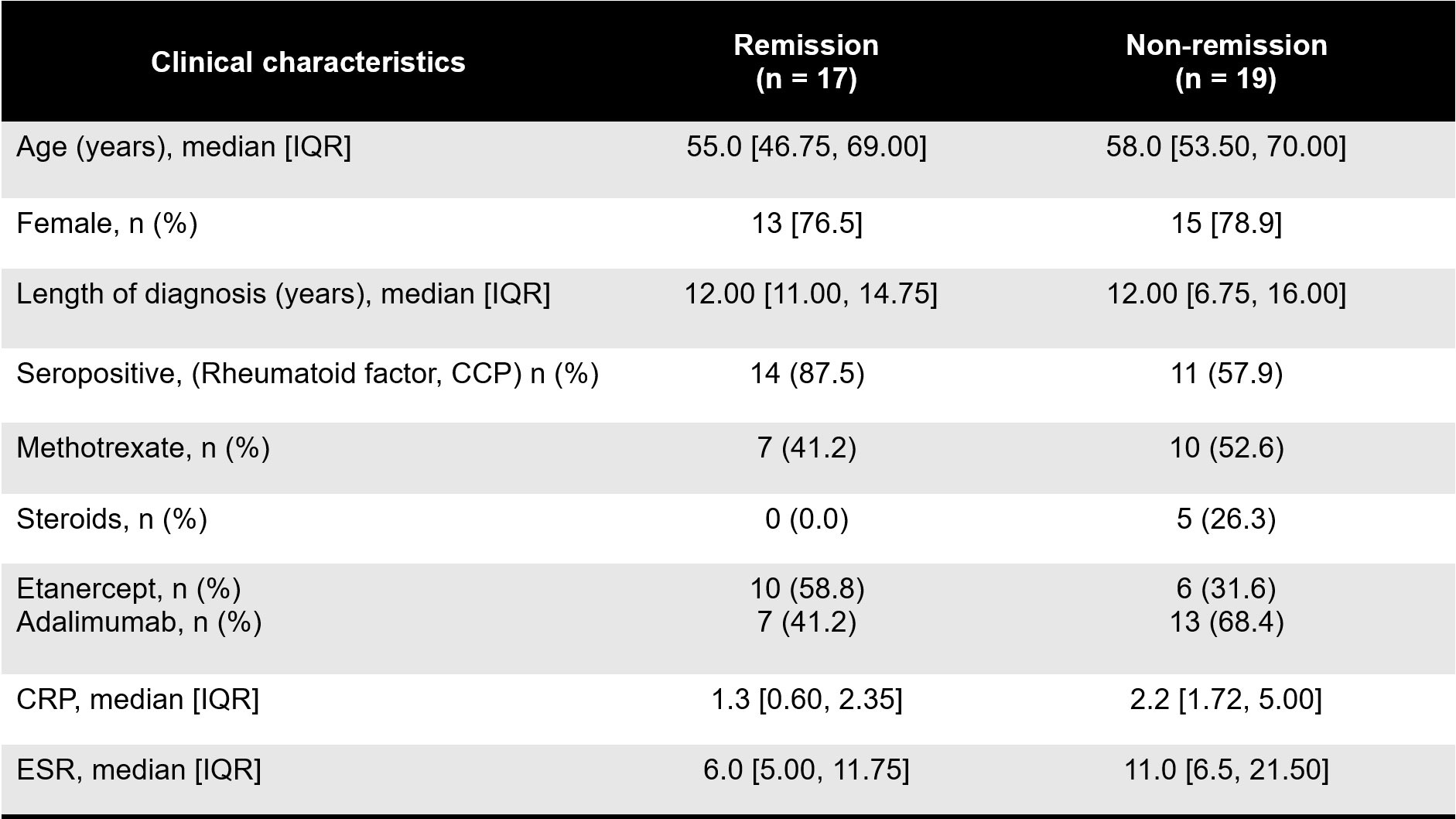Session Information
Date: Monday, November 14, 2022
Title: T Cell Biology and Targets in Autoimmune and Inflammatory Disease Poster
Session Type: Poster Session D
Session Time: 1:00PM-3:00PM
Background/Purpose: Enrichment of highly differentiated T cells have been reported in rheumatoid arthritis (RA) patients compared to healthy individuals. The role of highly differentiated T effector memory re-expressing CD45RA (Temra) in RA is unknown, including whether they can be used as a marker of sustained disease activity. Our aim was to investigate whether peripheral blood Temra frequency can be used to identify RA patients with active disease refractory to anti-TNF therapy. As cytomegalovirus (CMV) has been reported to be associated with the expansion of Temra, we also investigated the relationship between serum CMV immunoglobulin (IgG) status, Temra, and remission status.
Methods: A cross-sectional cohort of RA patients on anti-TNF therapy were recruited (Table 1). Patients were stratified based on remission status with remission defined as no recorded DAS28-CRP≥2.4, no swollen joints, no C-reactive protein (CRP) >5mg/L, and on a stable DMARD dose and no reported disease flare/loss of remission in the last 6 months before recruitment. Patients on abatacept or on methotrexate monotherapy were recruited as comparison groups. Peripheral blood mononuclear cells (PBMC) were analysed by flow cytometry. Where available, CMV IgG in serum was analysed using semi-quantitative ELISA. Two-tailed Mann-Whitney U test or unpaired t-test were used to obtain unadjusted values, analysis of variance (ANOVA) of log-transformed data was used to obtain age-adjusted values, Spearman’s rank correlation was used to compare correlation between two variables, Fisher’s exact test was used to compare proportions.
Results: Thirty-six anti-TNF, 12 abatacept, and 16 methotrexate monotherapy patients were recruited. There was a higher proportion of CD4 and CD8 Temra (age-adjusted p = 0.004 and p = 0.0007 respectively) in RA patients on anti-TNF with persistent disease compared to those who had achieved remission. The difference in Temra frequency observed between anti-TNF patients in remission and those with persistent disease was not observed in patients treated with methotrexate or abatacept. The frequency of CD4 and CD8 Temra correlated with CRP only in patients on anti-TNF (Spearman r = 0.5185, p = 0.001, and Spearman r = 0.5040, p = 0.005, respectively). CD4 and CD8 Temra also correlated positively with CMV IgG levels in anti-TNF treated patients (Spearman r = 0.38, p = 0.03, and Spearman r = 0.56, p = 0.002, respectively). There was a significantly higher proportion of CMV seropositivity in anti-TNF patients with persistent disease compared to anti-TNF patients in remission (Fisher’s exact test, p = 0.009). This difference was not present in the other treatment groups.
Conclusion: These results suggest that Temra may play a role in driving RA disease specifically unresponsive to anti-TNF therapy. The association between CMV seropositivity and persistent disease only in anti-TNF treated patients may provide a causal link between Temra and RA pathogenesis refractory to anti-TNF treatment.
To cite this abstract in AMA style:
Yeoh S, Kimpton J, Shipa M, Hawkins E, Akbar A, Ehrenstein M. Increased Frequency of Highly Differentiated T Effector Memory Cells Re-expressing CD45RA (Temra) and Cytomegalovirus Seropositivity Are Associated with Persistent Disease Specifically Refractory to Anti-TNF Therapy in Rheumatoid Arthritis [abstract]. Arthritis Rheumatol. 2022; 74 (suppl 9). https://acrabstracts.org/abstract/increased-frequency-of-highly-differentiated-t-effector-memory-cells-re-expressing-cd45ra-temra-and-cytomegalovirus-seropositivity-are-associated-with-persistent-disease-specifically-refractory-to-a/. Accessed .« Back to ACR Convergence 2022
ACR Meeting Abstracts - https://acrabstracts.org/abstract/increased-frequency-of-highly-differentiated-t-effector-memory-cells-re-expressing-cd45ra-temra-and-cytomegalovirus-seropositivity-are-associated-with-persistent-disease-specifically-refractory-to-a/

